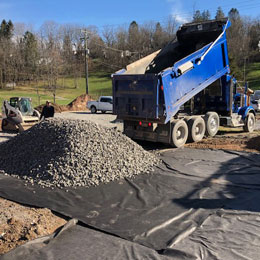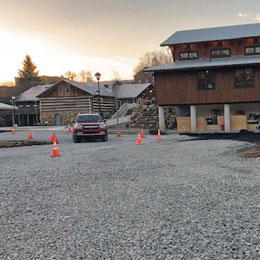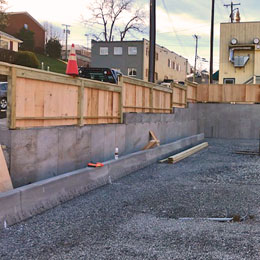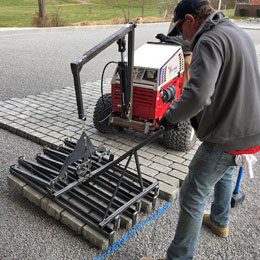

11/14: Erecting retaining wall forms.

11/14: Forms complete, ready to pour.

11/19: Working on the headwall footer.

11/23: Pouring the headwall.

11/24: Wall complete, excavation beginning.

11/24: Excavating for the subdrain system.

11/24: Hauling off the excavated material.

11/25: Rolling the base to eliminate future settling.

11/25: Spreading 300 tons of #2 crushed rock base over filter fabric.

12/2: Market lot filter fabric, subdrain, and conduit in place.

12/2: Spreading the #2 limestone base for the Market lot.

12/3: Rolling the temporary detour around the driveway.

12/3: Spreading the #2 crushed stone base for the detour.

12/3: Detour around the driveway is complete.

12/4: Filter fabric and #2 crushed stone base for the Market lot.

12/4: Covering the driveway sub-drain with #2 crushed stone.

12/4: The temporary driveway is complete.

12/4: The pad for the recycle shed is being poured.

12/4: The curb lines for the Market lot will be laid out on the limestone base.

12/4: The first curb is being poured and over 350 feet of curb will have been poured that day.

12/4: The long curbs in the Market lot have been poured and the recycle shed is on its new pad.

12/11: The curbs for the islands in the Market lot have been poured.

12/4: The safety fence along the Asylum and Lafayette Street walls is almost complete.

12/18: The sidewalk along the recycle shed and the pad for the grease tanks have been poured.

12/18: The #57 limestone is ready to be spread as the second layer of stone under the pavers.

12/18: Now that the island curb and light base have been poured, 6" of #57 limestone have been spread to support the pavers.

12/21: Excavating for the apron that will connect the driveway to Lafayette St..

12/21: The limestone base and rebar are in place, concrete is being poured, and the concrete is being finished.

12/21: Using a concrete pump truck made it possible to pour the dumpster pad, apron,and separator strips in one day.

12/21: Concrete is being pumped into the dumpster pad.

12/21: This separator strip will allow heavy equipment to use the driveway while the pavers are being installed in the parking lot.

12/23: The concrete sidewalk, pads for the dumpster and grease tanks are complete and the electric service panel has been mounted.

12/23: #57 limestone is in place in both lots and the driveway although heavy equipment is still needed for several final operations.

12/23: After final grading, the #57 limestone will be rolled and 2" of #8 limestone will be spread as final support for the pavers.

12/23: The concrete apron slopes up to the driveway to ensure that all stormwater running down Lafayette St. stays there.

12/29: Approximately 100 tons of #8 stones have been delivered and are ready to be spread and leveled.

12/29: leveling the bedding stones ensures that the pavers will be level when they are installed in the next step.

12/29: A soldier course of pavers forms an attractive border that separates the paver field from the curb.

12/30: A layer of 30 pavers is lifted from a pallet by an ingenious clamping device that Martin designed.

12/23: The layer of 30 pavers is carefully aligned and placed on the #8 bedding stones.

12/30: Pavers have been installed and aligned from the recycle shed to the Market building.

12/30: The security fence above the retaining wall is now complete. It runs from the corner by the demonstration garden to entrance on Lafayette St.

1/8: The last row of pavers along the edge has to be cut in preparation for installing the soldier course as a border.

1/8: The pavers for the soldier course at the end of the island have been trimmed and installed.

1/9: After all the pavers and soldier course have been installed, #8 stones are swept into the spaces to lock the pavers in place.

1/20: The tractor quickly spreads the stones, locking them in place yet letting them move slightly when a heavy vehicle runs over them.

1/20: The final step is to run a vibrating plate compactor over the pavers several times so they will all be at the same level.

1/20: Installation of the pavers is complete - the pavers have been aligned, stones swept in the joints to lock them in place, and compacted.

1/23: Construction is complete, next comes installation of lights, parking signs, landscaping, striping, . . . .